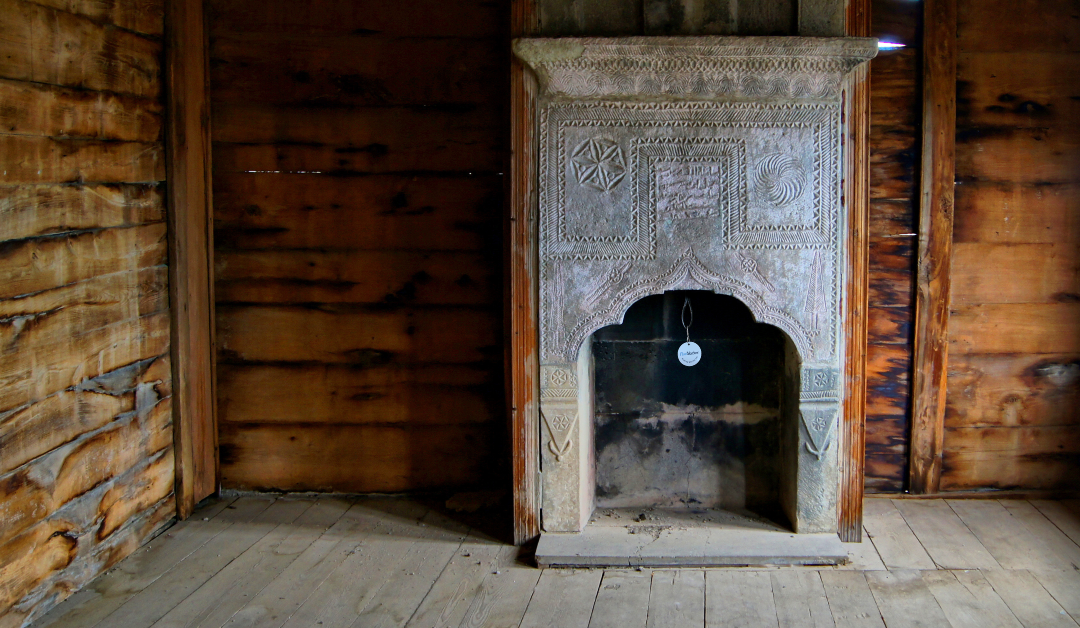
by blogediter | Sep 13, 2023 | Fireplaces
So you have old fireplaces in a home from the early 1900’s, or 1800’s to 1700’s?
Historic homes with old fireplaces are often wide open or have broken dampers and hardware that rusted and rotted-out a long time ago. It is impossible to get parts for these old fireplaces, because they were custom made by metalsmiths that have long passed.
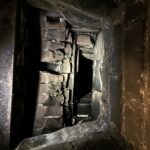
Jagged old fireplace
Old historic homes in general are filled with history and character and wonderful features from a by-gone era. But they are also a lot of work and they are full of surprises. Upgrading or fixing the old fireplaces in a home that is over 100 years old can be a challenge, but it will require some measurements and perhaps a custom sized Flueblocker chimney plug. Or you may have to trim the wool pad of the Flueblocker to fit an irregular shape or size.
Look for a location above the firebox that is low enough to touch with your hands, that you could install a Flueblocker into. Measure the length and depth of that area and buy a Flueblocker that is a little larger than that space. If it is an irregular or trapezoidal shape be sure to measure the widest points and narrowest points.
Best way to close off an old fireplace?
Often the wool padded Flueblocker is better than an inflatable Chimney Balloon in these old fireplaces, because the broken bricks and sharp rusted metal can cause punctures to an inflatable chimney plug. Also the Flueblocker can be ordered in custom sizes to accommodate very large openings, and you have the option to scissor-cut them to fit if needed.
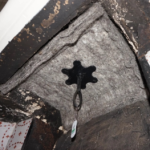
Flueblocker above the firebox
Construction materials are different in old fireplaces
Because old fireplaces are often thoroughly coated with years of creosote, ash, and soot it is best to seal the chimney as low as possible to seal out the smokey and sooty smells of the smoke chamber and flue. Old fireplaces are generally brick and mortar from top to bottom, and do not have modern featured like a clay or stainless steel flue tile.
The brick and mortar can often be crumbly or broken from centuries of wear and tear. You cannot assume a fireplace is even safe to burn in. It is important to have a level 2 chimney inspection done before an old fireplace is used for burning. In my experience, historic homes rarely have fireplaces that can be used before they have extensive work done. The old fireplaces may have worked well centuries ago, but they need an upgrade to work today.
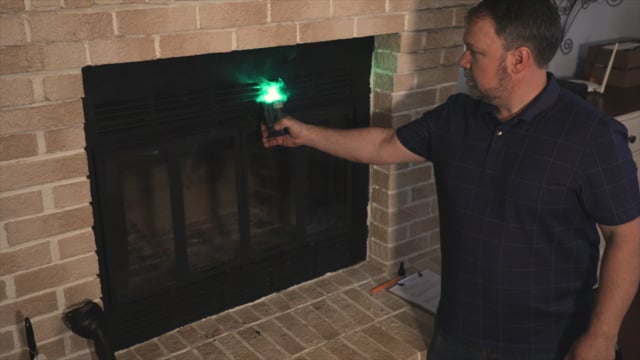
by blogediter | Sep 6, 2023 | Chimney Problems
How to use a Smoke Pencil in a fireplace to test for smoke draft, air leakage, or downdraft.
Fireplaces are designed to move air. The Dept of Energy estimates the fireplace makes up 14% of a homes air leakage. But many times we do not want our fireplace to do move air. We just want our fireplace to sit there in the corner and look pretty, and not let in outside air that is too hot or too cold, or suck out our inside air that we paid dearly for our HVAC to condition. But despite your best efforts of air sealing and troubleshooting, you still get drafts or smells coming from the fireplace.
Using a Smoke Pencil in a fireplace is the right tool to visualize the air currents
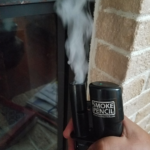
Smoke Pencil in a Fireplace
Air infiltration can come from an number of locations in a fireplace, Here are a few: the chimney, the brick connections, the fresh air intake, the ash chute, outside ash dump door, the glass door, the heat exchanger, etc…So even if you have a Chimney Balloon or a Flueblocker installed in your fireplace, you may still have air movement in your firebox that needs to be addressed.
It can be tricky to know whether the air is coming from up the flue or from the walls or the floor of the firebox. So the Smoke Pencil in a fireplace allows you to make puffs of vapor or trailing lines of vapor so you can pinpoint where the air is coming from.
Here is a list of some of the areas to check in your fireplace for air infiltration:
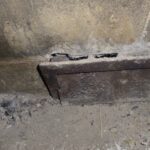
Ash chute door
- Ash Chute Dump: On the floor of your fireplace there can be a small trap door or a grate that leads to a hollowed out chute below. This is an ash chute. It is a cleanout for the firebox so you don’t have to scoop out the ashes after a fire. But it is always best to scoop out the ashes from the firebox, so you can get them out of the house. Ashes left in the chute can retain a burnt smell and that will come up from the chute and stink up the house.
- Ash Chute Dump Cleanout Door: If you have an ash chute, there there will be a cleanout door or port either on the outside wall of your fireplace, or in your basement or crawlspace. These doors are notoriously leaky and provide a perfect location for air to get sucked into the firebox.
- Fresh air intake: There is sometimes a fresh air intake on the side of the firebox wall. It directly lets in outside air for the fire. But it is also very drafty when not in use. Sometimes in factory built or prefabricated zero clearance fireplaces, you wont even see them because they are hidden behind the fire brick layer. But if air is getting sucked through the wall of the firebox, you will know that you have a fresh air intake.
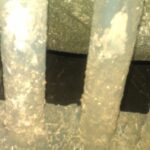
fireplace heat exchanger
- Heat exchanger: Many hearth constructions have grates that look like they serve no purpose, but they are part of a rudimentary heat exchanger. The thought is, if they leave open pockets around the firebox then those pockets will collect warm air during a fire. That air will circulate and come out into the room. Some even have fans attached to force the air around. But those air pockets can also let in outside air.
- Glass Doors: It may seem counterintuitive but glass doors can let in outside air in prefabricated fireplace. The glass door tracks are built into the metal box that also has the damper and chimney and attach the firebox walls. Those metal attachments can leak air, and it shows up through air infiltration the glass door tracks.
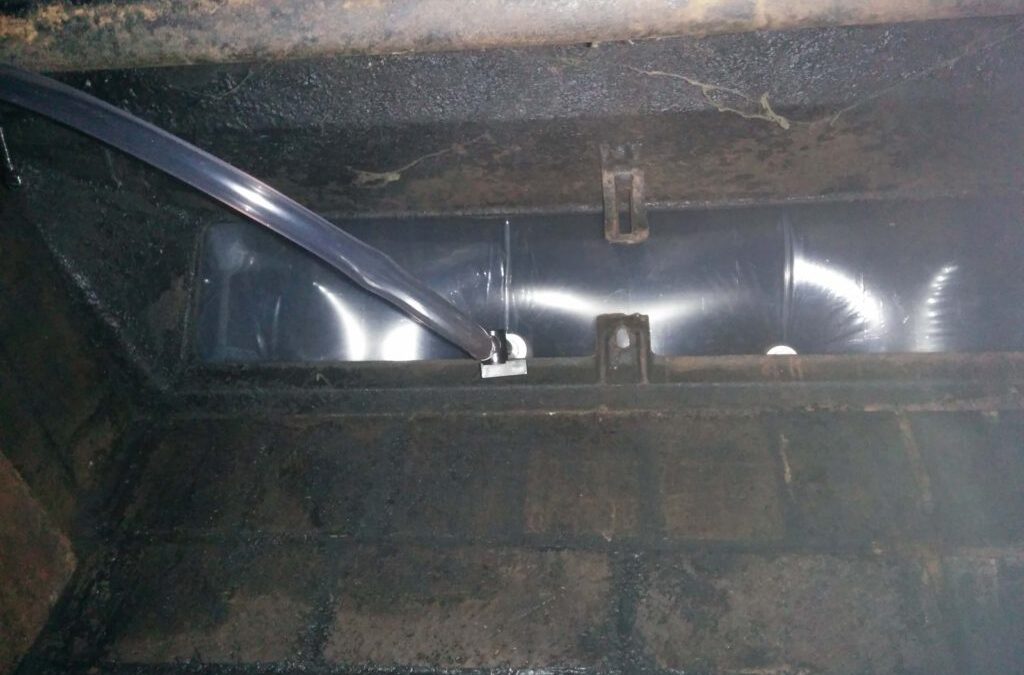
by blogediter | Aug 30, 2023 | Chimney Plugs
You are probably saying to yourself: “Wait, aren’t you the Chimney Balloon guy? Why would you tell me reasons Chimney Balloons are a bad idea?”
The reason is, I am an honest guy. And there is no chimney plug or metal damper that is the absolute best for every kind of fireplace and every home out there. There is no one size fits all magic product, and there are no chimney plugs or dampers that will make everyone happy. They all have advantages and disadvantages. I am writing a series of blogs that cover each kind or metal damper and chimney plug, and what they are good at, and not so good at.
If you think, I will just call my chimney sweep guy and he will clean my chimney and make all the bad soot go away, and he will tell me how to fix my drafty, buggy, or stinky chimney. You will get your chimney cleaned and 99% of the time they will pitch you for a chimney top damper that will cost $400 to $900 (depending upon how dangerous it is to get to your chimney crown).
Then you will find that a top seal damper closes the chimney, but creates more stink. Often a top seal damper makes the draft worse and the stink worse because you are bottling a chimney at the top. We sell all kinds of chimney plugs to new top seal damper owners. Because to fix drafts and chimney stink, you have to seal a chimney low and tight.
Chimney Balloons are not the best solution for every fireplace and wood stove chimney. But they are the best solution for some fireplace applications, and I will tell you which are the good ones and the bad ones.
First lets cover what Chimney Balloons are good for:
1) Chimney Balloons work well if you need a safety breakaway. Look, every household has a klutz in it. If you think there cant be one in your house…hmm maybe you might be it? Or maybe you have a visiting klutz that comes over at Thanksgiving? Anyway, if you need a chimney plug that will break away and fall out if someone lights a fire under it by accident, then an inflatable Chimney Balloon would be a fit. Especially if the chimney you are plugging is a long or a short term rental. People do weird stuff in rentals, so make sure you leave a clear and unmistakable sign in the firebox that the chimney is plugged.
2) Chimney Balloons work well if you need an extra tight seal to keep out bats or insects. Little critters can get through extra small spaces, and creep around corners. Insect mandibles and bat teeth cannot puncture a Chimney Balloon. Since a Chimney Balloon inflates wall to wall and pressure fits. It is an impenetrable barrier for those little critters. It also works well to seal kitchen smells from wafting up the flue. Kitchen smells rise up and out with heat, and often attract in flies and bugs.
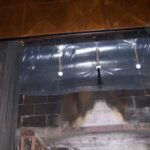
Chimney Balloon in wide open flue
3) Chimney Balloons work very well with open flues with no hardware. You can often get the tightest seal with a Chimney Balloon. The wall to wall pressure fit is ideal for sealing a straight wall chimney. Thanks to a variety of HEK handle extenders you can even install a Chimney Balloon a bit higher in the chimney flue. This is a unique accessory.
When Chimney Balloons are a bad idea?:
1) Chimney Balloons are a bad idea, when you don’t have enough vertical space . Small Chimney Balloons are about 5″ tall when inflated, and Large Chimney Balloons are about 9″ tall. You also have to accommodate the 6″ black handle valve sticking down the bottom. Sometimes a Chimney Balloon simply cant fit the area you want to put it in. The Flueblocker chimney plug has a 1″ thick wool pad, and a removable handle, that is better for tight spots with little vertical space.

When Chimney Balloons are a bad idea
2) Chimney Balloons are a bad idea, when the walls are opening downward. The Chimney Balloon needs to grab the walls in the location it is trying to install. If the walls are metal, and have no texture. Or they are sloped opening downward too sharply, then the Chimney Balloon can’t grab the walls.
3) Chimney Balloons are a bad idea, when there is sharp hardware like screws of exceptionally abrasive walls. Chimney Balloons are inflatable. They have a tough but flexible multi layer membrane, but they are subject to getting punctured. They can also wear out over time. We have more durable chimney plugs like the Flueblocker that will hold up better to rough walls and sharp hardware.
4) Chimney Balloons are a bad idea, if you use your fireplace a lot. Speaking of bad ideas...using your fireplace a lot is a bad idea as well. But Chimney Balloons take some effort to install and take out. If you use your fireplace a lot, then it is likely a sooty and ash laden mess in your firebox and flue. There are easier ways to seal off the damper.

by blogediter | Aug 23, 2023 | Press
Suzanna Blake with the US Sun online magazine, wrote a Flueblocker article on how to save money on Summer A/C costs.
Growing up in Wisconsin taught me quite a lot about air sealing and insulation for the winter months. However, living the last decade in the hot humid latitude of South Carolina has taught me a lot about weatherproofing for the summer. This Flueblocker article covers some of the methodology that is similar in both states, but the goals tend to be different to beat the heat.
The high energy use months are May through September in the South.

Flueblocker article on WI winter
My focus in Wisconsin was keeping my natural gas bill down in the winter. If you are interested in another US Sun article covering low hanging fruit of heating savings in drafty Wisconsin cottages, you can look at this story.
Here in South Carolina my focus is bringing my electrical bill down in the summer. And considering I am running a 2400 sq ft, 2 story, 4br, traditional stick built in 1985 on about $50 per month electrical bill. I would say I have found a good deal of success. The Flueblocker article in the US Sun covers how I managed to do it.
I won’t give away too much from the article. Suzanne Blake says it much better than I can. But you will find that I speak of chimney plugs, attic gable vents, closed cell foam air sealing, solar, etc…
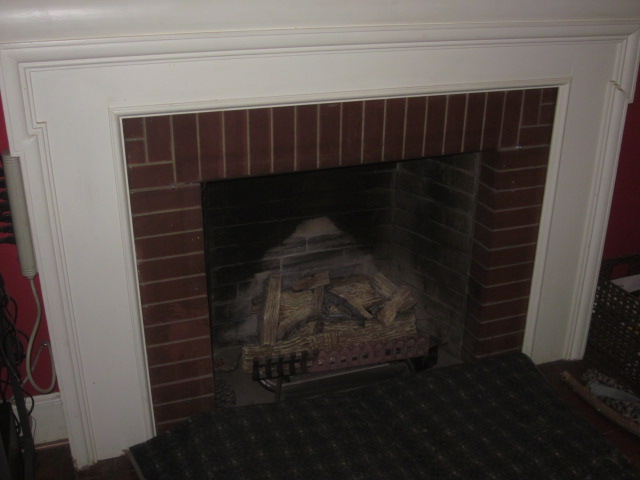
by blogediter | Aug 22, 2023 | Gas Logs
So you bought a vent free gas log or a vented gas log to retrofit your fireplace from wood burning into “clean” gas burning, and you wonder can I plug a gas fireplace chimney?
You read all about how your “clean” burning gas log can operate at 99% efficiency, because it doesn’t need to be vented through a chimney to the outside. Now, you are wondering how to plug a gas fireplace chimney, so you can keep all that heat in the house?
Honestly, I don’t know how installers or manufactures of gas log fireplaces can in good conscience sell gas log retrofits anymore. Vented gas logs are a setup for drafty rooms and high gas bills with no heat to show for it. Vent free gas logs are promoted as “clean burning”, even though they have been proven by a University of IL study that shows they put high levels of NO2 fume contaminants into your home.
Just google “vent free gas log dangers” and you will see hundreds of articles on that topic. Some US states have banned them entirely, for good reason! You will notice all the “Pro” gas log articles are by places that benefit from you buying one, and the “Con” articles are health agencies or building science agencies.
Personally, If I bought a house with a gas log of any kind, the first thing I would do is pull that gas log out and plug a gas fireplace chimney afterward.
Let’s zoom out and look at the different types of gas burning fireplaces, and how you can use them.
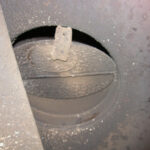
Clamp to hold damper open
Unvented gas logs (also called vent free gas logs) should not be retrofitted into a firebox that is a wood burning fireplace. You cannot simply drop one in, run a gas line to it, and plug a gas fireplace chimney. You can’t plug a gas fireplace chimney with a Flueblocker, a Chimney Balloon, or a metal damper of any kind. The reason is it will burn a non-metal chimney plug, and a metal damper can cause heat and fume spillage into the house in a manner that is not safe. Odds are your mantel area is not designed to have the intense heat of a vent free gas log spilling up the face of it.
Vented gas logs are mostly designed to be retrofitted into and old wood fireplace. But the downside is, by code you will need to clip open or remove the damper from the fireplace. This leaves a sizable hole open all the time. It is like me telling you to keep a window open 6″ all year long. Why would you want to do that? You wouldn’t!













